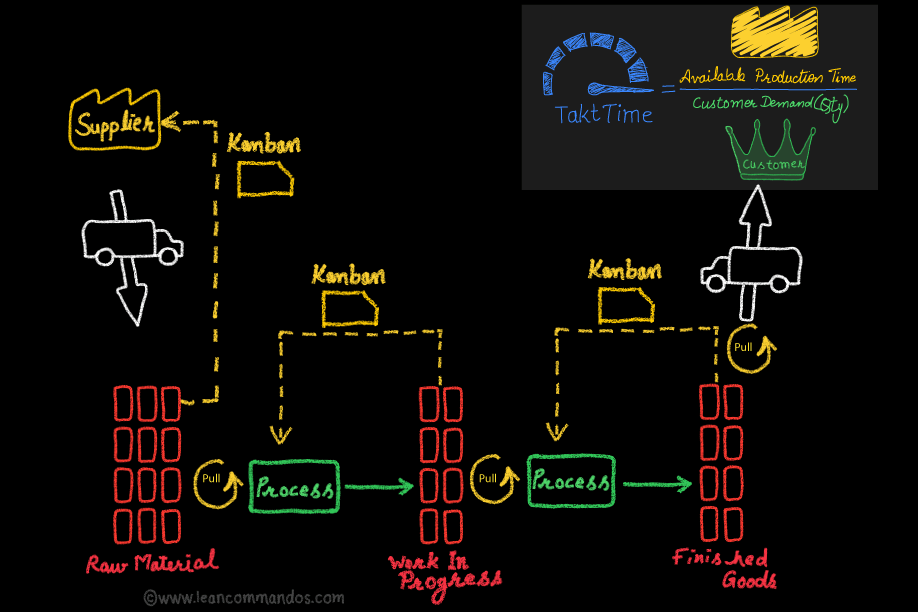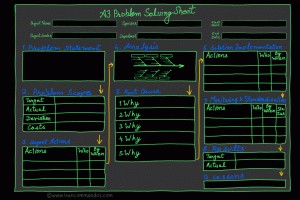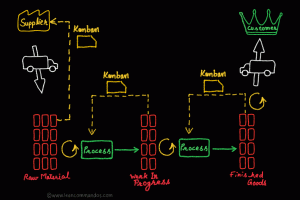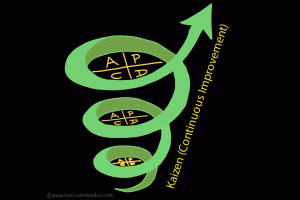Introduction
In the dynamic world of manufacturing, Just-In-Time (JIT) production stands as a cornerstone of Lean management principles. It is a strategy that streamlines manufacturing processes by minimizing waste and enhancing efficiency through the timely acquisition of materials and goods.
History and Development
Developed in Japan at Toyota in the early 1970s, JIT emerged as a response to limited resources and the need for efficient production systems. It was part of the Toyota Production System (TPS), conceptualized by Taiichi Ohno, the father of JIT, to address the issue of overstocking and reduce storage costs.
Key Principles
JIT is anchored in three fundamental principles: Takt Time, which aligns production with customer demand; Flow, which ensures that products move through the production system without delays; and Pull, which means that nothing is produced until it is needed.

When to Use the Tool
JIT is most beneficial when used in manufacturing environments that have high-volume, high-quality production goals, with a need to reduce inventory levels, enhance operational efficiency, and decrease waste.
How It Works
At its core, Just-In-Time (JIT) production operates on the fundamental principle of synchronizing production with customer demand. Unlike traditional manufacturing approaches that rely on predictive forecasting, JIT dynamically adjusts production schedules based on real-time customer needs. This dynamic responsiveness is facilitated by a series of interconnected processes and practices aimed at minimizing waste and maximizing efficiency
Central to the JIT methodology is the concept of Kanban, a signaling system that governs the flow of materials and information throughout the production process. Kanban serves as a communication tool between different stages of production, indicating when and what to produce next. These signals are triggered by the depletion of inventory at various production points, ensuring that items are replenished only when needed.
An essential aspect of JIT implementation is the establishment of a pull-based system, wherein each stage of production “pulls” materials or components from the preceding stage as required. This creates a seamless flow of materials through the production process, eliminating the need for excess inventory and reducing the risk of overproduction. By aligning production with actual demand, JIT minimizes inventory holding costs and optimizes resource utilization.
Successful JIT operation relies on several key factors. Firstly, a stable and reliable production process is essential to maintain consistency and minimize variability. Highly skilled and adaptable workers are equally critical, as they enable efficient operation and quick response to changing production requirements. Additionally, fostering strong relationships with suppliers is paramount, as JIT relies on timely deliveries of high-quality components in small, frequent batches.
The physical layout of production facilities also plays a crucial role in JIT implementation. Many companies adopt U-shaped production cells, which facilitate communication and collaboration among workers and streamline material flow. This layout promotes flexibility and enables rapid reconfiguration of production lines to accommodate changing demand patterns.
Furthermore, JIT encourages continuous improvement and waste reduction through practices such as Total Quality Management (TQM) and Kaizen. By emphasizing the pursuit of perfection and incremental enhancements, JIT organizations continually strive to optimize processes, enhance product quality, and exceed customer expectations.
In summary, JIT production represents a holistic approach to manufacturing that prioritizes responsiveness, efficiency, and waste reduction. By aligning production with customer demand, minimizing inventory levels, and fostering collaboration across the supply chain, JIT enables organizations to achieve significant improvements in productivity, cost-effectiveness, and competitiveness.
Benefits
JIT can lead to significant improvements in a manufacturing operation, reducing waste, cutting costs, and increasing productivity and product quality. The reduced inventory levels free up capital for other uses and decrease the risks associated with excess stock.
Case Studiy
A notable case study of JIT success is Harley-Davidson. Facing stiff competition in the 1980s, they adopted JIT principles to revamp their production. This led to a reduction in inventory levels by 75% and a production time cut from 18 months to two weeks, significantly increasing their market share and profitability.
Common Mistakes and Pitfalls
Common pitfalls in JIT implementation include underestimating the importance of supplier relationships, inadequate training for workers, lack of commitment from management, and ignoring quality issues. These can lead to disruptions in production and reduced efficiency.
Tips for Success
Successful JIT implementation requires a commitment to continuous improvement, a strong relationship with reliable suppliers, effective communication channels, and thorough training for employees in multiple skills.

FAQs
How does JIT handle unexpected spikes in demand?
JIT systems can be flexible with a buffer stock or by maintaining strong supplier relationships for rapid response.
JIT suitable for all types of industries?
JIT is ideal for industries with predictable, high-volume demand but can be adapted with
modifications to various environments.
How does JIT affect supplier relationships?
It requires close collaboration and often long-term partnerships with suppliers for timely deliveries.
Can JIT be implemented in a service industry?
Yes, JIT principles can be adapted to reduce waste and improve efficiency in service settings.
What are the risks of JIT?
Risks include supplier failures, quality issues, and demand forecasting errors which can disrupt production.
Integration With Other Lean Tools
JIT works hand in hand with other Lean tools such as Total Quality Management for ensuring quality, and Kaizen for continuous improvement, creating a robust, efficient production system.
Conclusion
JIT production is not just a manufacturing strategy but a comprehensive approach to business processes that can yield significant competitive advantages.
References and Further Reading
For deeper insights into JIT production, consider the following books by renowned authors:
- “The Toyota Production System” by Taiichi Ohno
- “Lean Thinking: Banish Waste and Create Wealth in Your Corporation” by James P. Womack and Daniel T. Jones
- “The Machine That Changed the World” by James P. Womack, Daniel T. Jones, and Daniel Roos. These texts offer a comprehensive look at the principles of JIT and its role in revolutionizing the manufacturing industry







7 Responses
You are my inspiration , I possess few web logs and infrequently run out from to brand : (.
Thanks for sharing excellent informations. Your web-site is very cool. I am impressed by the details that you?¦ve on this site. It reveals how nicely you perceive this subject. Bookmarked this website page, will come back for more articles. You, my friend, ROCK! I found simply the info I already searched everywhere and just could not come across. What a great website.
Someone essentially help to make severely posts I might state. This is the first time I frequented your website page and so far? I amazed with the analysis you made to make this particular submit extraordinary. Magnificent process!
It?¦s really a great and helpful piece of info. I am happy that you just shared this helpful information with us. Please stay us up to date like this. Thanks for sharing.
Thank you ever so for you article post.Much thanks again. Will read on…
Appreciate it for helping out, good information.
Today, I went to the beachfront with my kids. I found a sea shell and gave it to my 4 year old daughter and said “You can hear the ocean if you put this to your ear.” She placed the shell to her ear and screamed. There was a hermit crab inside and it pinched her ear. She never wants to go back! LoL I know this is entirely off topic but I had to tell someone!